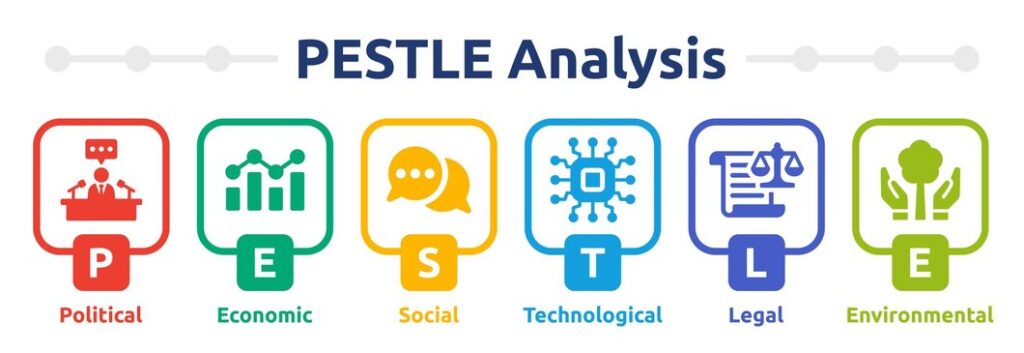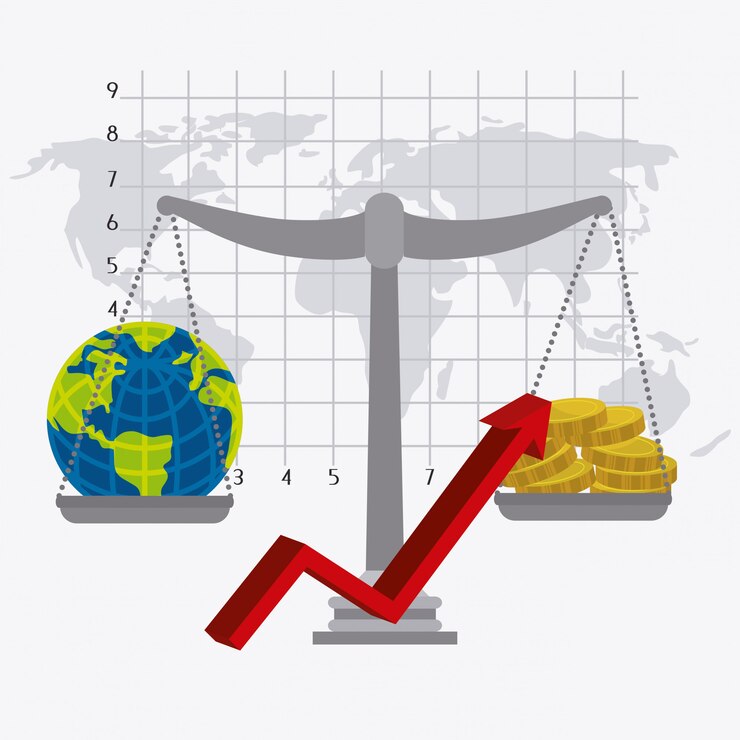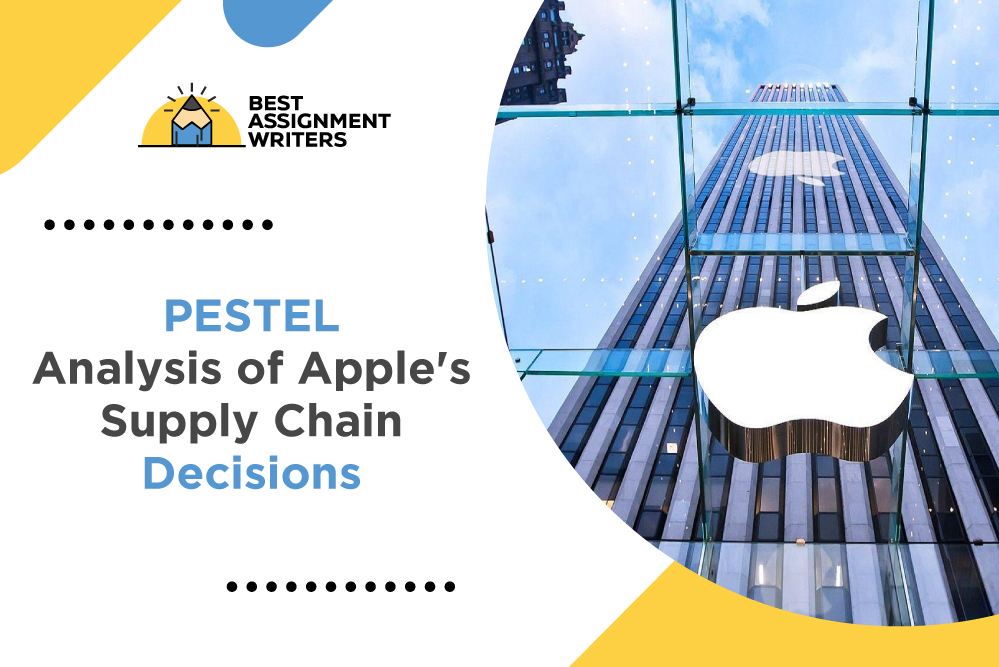You must be aware of the influence of Apple computers, as this brand has a huge impact on society. Apple’s supply chain and manufacturing have quite a positive influence on the border’s economic landscape. This outstanding brand was launched by Steve Jobs, Ronald Wayne, and Steve Wozniak in 1976. What if we tell you this business was initially based on the garage, which later became a global tech giant?
The PESTEL analysis shed light on how factors such as government policies, economic conditions, consumer preferences, technological advancements, environmental concerns, and legal regulations could influence Apple’s operations, strategies, and overall performance. Apple can maintain its position as a global leader in the technology industry by anticipating and adapting to these external forces.
This industry has moulded tech industries and the behaviour of customers along the way. But do you know this brand’s success credit can’t be given to the product?
However, Apple, despite its immense success, is not immune to the external forces that shape the business landscape. In this blog, we will discuss PESTLE analysis to find the key political, economic, social, technological, environmental, and legal factors that could significantly impact Apple’s future trajectory. Did you know that, before choosing the bitten apple logo, the company’s initial logo represented Sir Isaac Newton sitting under an apple tree? But it was deemed too complex and was replaced with an apple silhouette.
About Apple
The Apple brand is a popular brand launched by Ronald Wayne, Steve Wozniak, and Steve Jobs. This company owns numerous electronic gadgets, including phones, music players, computers, laptops, and so on. Let us tell you a fun fact about this brand: Apple registered an annual revenue of $383.29 billion in 2023. Whereas, there are about 2.2 billion active Apple devices globally. Its ability to adapt and navigate the external environment should be honoured.
Did you know their model is primarily based on developing proprietary software? This company has a full-fledged operating system for their gadgets. The interesting fact about Apple is that it has become a leader in information services by becoming the biggest online music retailer, which includes video streaming. You can even find around 3.84 million applications in the Apple App Store.
PESTLE Analysis of Apple
Apple PESTLE Analysis is a business industry analysis framework that managers use to identify the economic, technological, legal, environmental, sociocultural, and political factors that may affect a brand or entire business. PESTEL analysis for Apple also aids the company in dealing with newly emerged competition in the market.

Political Factors in Apple
Did you know about states’ policies regarding business organisations? If not, then no worries. The government’s policies are essential factors that can affect business expansion in a country. However, the limitations imposed by the government include labour laws, taxes, foreign trade policies, anti-corruption laws, and so on. These policies form the core of the political factors of PESTEl analysis.
According to the details, Apple Computers figures at $195.57 billion, which concerns the cash balance. However, Apple outsources its manufacturing to China, and the conflict between the US and China has escalated. This has imposed limitations on imports to renew the US manufacturing business. Here are some of the political factors in Apple PESTEL that you need to know:
- International trade policies
- Regulatory environment
- Taxation policies
- Political stability
- Government support for technology
- Environmental regulations
- Data protection policies
- Intellectual property protection
Ecological Factors of Apple
Did you know that this brand tried to extend its business? Back in the 1980s, Apple released a collection of clothing and accessories. However, Apple’s attempt to enter the fashion industry was short-lived. You must know that every economic factor has its own significance that deals with the revenue of the organisation.
So, what they need to do is acquire a comprehensive image of the economic factor and consider various aspects, such as production cost, employment rate, raw material interest rate, and the list goes on. This provides the owners with a transparent concept of the purchasing ability of the consumers. Business owners can even plan their product-selling process to ensure a reliable profit margin.
However, the demand for higher wages among Chinese employees may affect Apple gadget production, which can harm the cost advantages. Here are some of the ecological factors that can affect sales:
- Global economic conditions
- Exchange rate volatility
- Inflation rates
- Interest rates
- Consumer income levels
- Market competition
- Supply chain costs
- Technological investment
Social Factors of Apple
Ever thought about how sociocultural aspects can help a company understand customer inclinations? This is crucial for gauging the product’s demand in a given niche. This aspect is considered under a pointer that includes heritage and culture, level of education, and population density.
These factors have led to Apple’s success, as customers have willingly accepted the use of smartphones. Even though it would be renewed or replaced in the future, its social status is no longer a constructive force for upgrading mobile gadgets as customers are looking for functional and cost-effective solutions.
In the mid-2000s, this brand worked with the U.S. Department of Energy to launch special iPods that could record and store data secretly. Meanwhile, the most highlighted social factors in the Apple PESTLE analysis are:
- Customer preferences
- Demographic trends
- Lifestyle changes
- Brand perception
- Cultural differences
- Social media influence
- Ethical and social responsibility
Technological Factors of Apple
Did you know the progress in information technology (IT) and recent innovations influencing the market? The significant factor in the PESTEL analysis that can help organisations grow is that they have to compete against other giant competitors, such as Google and Samsung. These companies produce quality gadgets for their customers. However, Apple is currently providing expensive tech products to its customers, and that doesn’t match top-notch innovation. Following are some technological factors in Apple PESTLE analysis that might help you understand even more:
- Rapid technological advancements
- Appearing technologies
- Cybersecurity threats
- Software and platform ecosystems
- Supply chain automation
- Sustainability and green technologies
- Digital payment systems
- Cloud computing
Economic Factors for Apple
So, the ecological aspect of PESTEL examines the potential of the firm and checks its ratio of growth and survival in a specific environment. However, pollution and climate change problems are handled sufficiently through the economic assignment help factors of PESTEL analysis.
Did you know the Apple brand can face environmental issues? The removal of Apple gadgets after they are no longer of any use is the most critical issue. However, the industrial emissions from manufacturing products in China are another problem, as China is enforcing stricter emission laws. So, it is time for you to look at some of the factors:
- Climate change
- Resource scarcity
- Waste management and recycling
- Energy efficiency
- Sustainable packaging
- Environmental regulations
- Consumer environmental awareness
- Biodiversity and ecosystem impact
Legal Factors for Apple
The legal facts for any business are the rules and regulations imposed by the Court of Law. That’s right. That’s why organisations need to stick to the customers’ laws, a safer working environment, industry regulations, and so on to avoid any legal violations.
The launch of Apple in the tech industry and financial services is a lucrative choice. Meanwhile, it is also quite a regulated field. You know what? Apple plans to expand its business. These business domains entail compliance and insurance for Apple. The company even needs to bear the litigation expenses to combat intellectual property theft and safeguard the products. Here are Legal factors for Apple:
- Intellectual property laws
- Data privacy regulations
- Antitrust and competition laws
- Consumer protection laws
- Employment laws
- Environmental regulations
- Tax laws
- Export and import regulations
Supply Chain, Inflation, and Sustainability

The sudden rise in prices, or inflation, often occurs when there’s more demand for goods than there are goods available. However, the government’s spending programmes and low interest rates can also contribute to inflation, putting a strain on supply chains.
Let’s look at the COVID-19 pandemic as an example. You must have noticed, if you are a business owner, that lockdowns forced business closures, but people received financial aid from the government. This newfound cash fueled a surge in spending on electronics, home goods, and renovations.
However, sudden demand skyrocketed while supply remained stagnant, causing prices to jump. Even when products were finally manufactured, shipping delays and skyrocketing ocean freight costs added further pressure. Did you know Apple had made significant efforts towards chain sustainability? That’s right. This is the reason the giant firm has set some goals that can help reduce its carbon footprint, minimise waste through the supply chain, and conserve water resources.
Inflation in supply chains can become self-perpetuating. To avoid stockouts or production delays, companies may order supplies much further in advance, leading to higher inventory storage costs. Worker shortages add to training expenses and decrease overall productivity, further hindering supply chains. The rising cost of transportation essentials like fuel, trucks, and equipment also acts as a roadblock.
Well, Apple has invested in renewable power projects, such as solar and wind farms, to reduce reliance on fossil fuels and to power its facilities.
Inflation Effect on the Supply Chain
You must know that changes in tech production and transportation costs, material availability, and customer buying power can inflame inflation in supply chains. Supply chain inflation can then preserve itself as these rising costs reduce a company’s purchasing power. These are some of the effects of inflation on the supply chain:
- Increased costs of production
- Reduced purchasing power
- Reduced availability of resources
- Increased prices are passed on to customers.
Final Thoughts
The Apple PESTLE analysis is an essential tool for organizations to understand the external force and identify opportunities and risks. Now, Apple can make informed decisions about navigating the landscape and maintaining its position.


